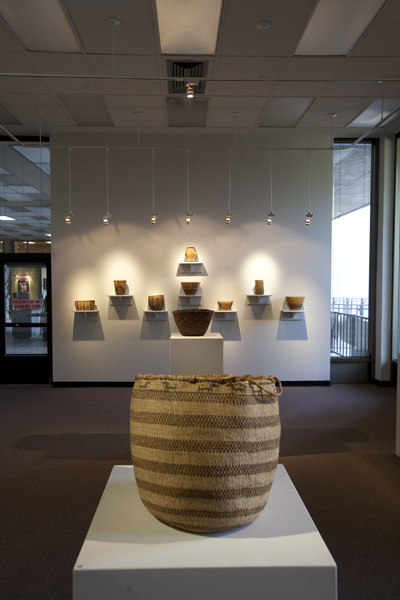Historical Native American artwork displayed at Sac State

These Pacific Northwest baskets show distinctive imagery relevant to the lives of the tribes in the region, on display in the Library Gallery’s Native American Art: The Spirit of the Basket exhibit running from Sept. 1 to Nov. 19.
September 13, 2011
A dual exhibit featuring a collection of northern American baskets from Native American history is being displayed in the Sacramento State Library Gallery through November.
The first exhibit in the Library Gallery Annex, running through Sept. 30, is titled “Object Lessons, the Basket Collections of Joel Sheldon Cotton and Anthony G. Zallio.”
Anthropology professor and museum director Terri Castaneda and graduate anthropology student Holly Lamb are curating the show. The baskets on display are the private collection of Cotton (1875-1952) and Zallio (1874-1951), accumulated throughout California and the Northwest.
“The captions, the display cases and the general arrangements were of the highest museum standards, and the whole show was of a quality that all of us in the CSUS family could be very proud,” said Mead Kibbey, volunteer for the California Indian Heritage Center.
The exhibit displays baskets, all woven by hand, ranging from trinket containers to food storage. Cotton and Zallio aquired them from dealers and weavers for artistic and indigenous use.
In the main hall, the introduction explains how Cotton and Zallio grew up during the anti-modernist era, when hand-craft was most popular as an adversary to modernist ideals, introducing the attraction to baskets and basket-making. This, along with ties to the local Pomoan and Miwok Indians, led Cotton to collect baskets as homage to the primitive arts, as well as his own pioneer settler heritage.
Zallio, an anthropologist, amassed his collection to preserve cultural objects for anthropological archives. Both collections were donated to Sac State after their deaths through relatives.
The two collections are normally on display or housed in the research collections of the university’s Anthropology Museum, but the arrival of “The Spirit of the Basket” exhibit has brought it into the gallery.
“The Spirit of the Basket,” the second exhibit, is running through Nov. 19. The exhibit displays the baskets of the California Indian Heritage Center. It is an accumulation of baskets collected from the Southeast, West and Pacific.
“This exhibit contained only about 100 baskets, carefully selected from some 2,500 which had not been publicly exhibited for over 25 years. These were, in the opinion of the curator, the very best of the best,” Kibbey said.
There are a wide variety of pieces to see, including marriage baskets, infant carriers, beaded containers and water jugs, to name a few.
“I took an American Indian History class and it was great to see everything up close,” said Kelsey McElroy, junior studio art major with a minor in Native American studies. “I think it’s great they brought this here.”
The baskets were originally displayed in the de Young Fine Arts Museum in San Francisco during the 1920s and 1930s, and were later donated to the California Indian Heritage Center, where they were moved to West Sacramento for storage. According to Phil Hitchcock, director of the Library Gallery, they remained there until just this month.
“It’s a rare opportunity to see this show since the baskets have rarely been studied,” said Leslie River, assistant to the Library Gallery Director. “They’re extraordinary and beautiful, and the detail and the mastery that must have gone into them makes them very stunning.”
Kibbey said a few baskets that stood out were the infant carriers, which besides their functional use, also protected a child’s spirit before a name was chosen. The beaded trinket boxes required a lot of skill to make – the beads were cut and then attached with wire, and the overall effect of the light catching the beads and colors woven into the basket were very complementary to each other.
“All the regions had indigenous plants which dictated the way baskets were woven and made, and that’s the spirit of the basket,” Hitchcock said.
There are a lot of unique aspects of basketry, such as usage of the resources available that identified each region or tribe. Hitchcock believes this is what makes this exhibit unique.
“It’s interesting to see the different types of fibrous materials used and how it molds the basket into what it is,” said Molly Okumura, freshman communication studies major. “I really appreciate that we can see the way another culture made something that was functional yet beautiful.”
Kaitlin Bruce can be reached at news@statehornet.com
































































































































